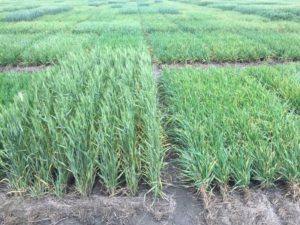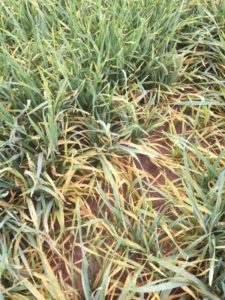by Dr. Clark Neely, Statewide Small Grains Extension Specialist, Texas A&M AgriLife Extension
2017 has been another interesting year once again for wheat growers in the Texas Blacklands and South Texas. Chances are you or someone you know who grows wheat has asked at some point, “What is wrong with my wheat?!” There appears to be a number of factors at play this spring causing wheat to look abnormal, poor, or “raggedy”. I will attempt to cover the most likely culprits and some less likely ones too in this article.
The two biggest issues that are affecting wheat right now in these regions appear to be 1) Vernalization issues and 2) Leaf rust (will get to in a moment). If you’ll remember last spring at this time producers in South Texas were dealing with vernalization problems also, as noted in this May 2016 RCNL issue (http://agrilife.org/texasrowcrops/2016/05/06/mild-winter-and-wet-spring-provide-challenges-for-wheat-producers/). Vernalization refers to the chilling hours required (<45oF) by winter wheat in order to switch the plant over from vegetative growth into reproductive growth (producing a seedhead). While this issue is nothing new for producers in South Texas, symptoms showed up as far north as College Station for the first time last year due to an abnormally mild winter. While one may have thought that last year was a bit of a fluke, 2017 appears to be even more severe with vernalization problems showing up in producer fields as far north as the Waco area, which is unprecedented.
The most common theme that appears in fields affected by low/no vernalization is a “ragged” or uneven maturity across the field, in some cases with only sporadic head emergence, leaving the majority of the field looking like a lush green carpet. In addition to vernalization requirements, many varieties have a “day-length sensitivity” that will signal the plant to go reproductive in addition to, or in place of, chilling hour requirements. Therefore, in some cases a variety may not receive enough chilling units to “vernalize”, but

Figure 1. Vernalization issues with winter wheat causing wide variation in maturity in variety trials across central and south Texas (Photo courtesy of Bryan Simoneaux).
will still initiate jointing when days get long enough. In the majority of these cases, maturity will be several weeks later than what is typically expected for those varieties. ‘WB Cedar’ is a prime example of this. It is typically considered one of the earliest HRWW varieties in the AgriLife Variety Trials; but will be one of the latest this year. While these varieties should still produce a viable grain crop, yield will likely be reduced as maturity is delayed into higher temperatures typically experienced later in the spring.
Results from the 2016 AgriLife Wheat Variety Trials in Wharton, TX show results of hard red spring, hard red winter and soft red winter wheat varieties side by side. Only a third of the hard red winter varieties were harvested and yields were lower overall compared to hard red spring varieties. All other winter varieties with no recorded yield were significantly delayed from poor vernalization. For specific variety performance please refer to:
http://varietytesting.tamu.edu/files/wheat/docs/2016/2016%20Wheat%20FINAL.pdf.

Figure 2. Yellowing in wheat caused by “flecking” of a resistant variety from leaf rust. Rust pustules may be limited or absent upon closer inspection (Photo courtesy of Ken Hilliard).
Leaf rust is also a major factor this spring. This disease is often seen overwintering in the College Station area and farther south. Mild winter temperatures allowed the disease to survive at elevated levels this year, providing a large inoculum load as temperatures warmed. Unlike stripe rust (which prefers cooler temperatures and fades away with warming temperatures later in the spring), leaf rust can continue to reproduce and spread well after wheat is headed out and can attack flag leaves if enough moisture is present. Rain events as well as heavy dews are conducive to development and spread of the disease.
There have been countless questions regarding “yellow” or “sick” looking wheat this spring in much of the Blacklands and South Texas, which may be a direct result of leaf rust. Numerous tissue samples have been sent off to AgriLife plant pathology labs with many coming back negative for leaf rust (and other diseases). Even with negative test results, leaf rust can still be the

Figure 3. Symptoms of wheat streak mosaic virus in wheat. Some wheat fields have been misdiagnosed with WSMV as a result of abundant flecking from leaf rust (Photo courtesy of Jacob Price).
culprit with resistant varieties. “Flecking” (yellow freckling) is often observed on leaves of resistant wheat varieties when a rust spores land on the plant. Under low to moderate levels of disease pressure, this flecking may go unnoticed or appear unalarming; HOWEVER, under high disease pressure, plants can be “flecked to death” as plants are bombarded with spores to the point where much of the leaf area has come into contact with rust spores and hence turned yellow. This can mimic symptoms of nutrient deficiencies or viruses in some cases, which has made diagnosis difficult as actual leaf rust pustules are absent or very limited in affected fields.
In addition to leaf rust and vernalization problems, there are a myriad of other, albeit less common, potential causes of poor looking wheat in the region. Nutrient deficiencies, other diseases, insects and weather related issues can all cause yellowing in wheat as well. At least one confirmed case of wheat streak mosaic virus was reported in Williamson County, but this does not appear to be a widespread issue in the area. There are a few reports of stripe rust as well, but again, this disease has been limited this year and not impacting wheat production on a large scale as was the case in 2015 and 2016. Also, Texas A&M AgriLife Extension Entomologist Dr. David Kerns confirmed some reports of southern corn rootworm in wheat fields in Central Texas. This appears to be a rather new pest in wheat, with the first confirmation in Texas wheat in 2016. Occurrence was likely brought on by mild winter conditions the past two years. The actual impact this pest is having on wheat is still unknown. For more information on possible causes behind yellowing in wheat, please refer to AgriLife Extension publication “Potential Causes of Yellowing During the Tillering Stage of Wheat in Texas” at http://varietytesting.tamu.edu/files/wheat/docs/2016/Yellow%20wheat%20publication.pdf.

Clark Neely
State Small Grains Agronomist
College Station, TX
cbneely@tamu.edu